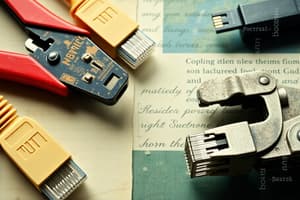Podcast
Questions and Answers
What tool is used to add connectors to the end of network cables?
What tool is used to add connectors to the end of network cables?
- Cable tester
- Network switch
- Wire stripper
- Cable crimper (correct)
Which type of cables can cable crimpers be used on?
Which type of cables can cable crimpers be used on?
- Coaxial, twisted pair, and fiber cables (correct)
- Only coaxial cables
- Only fiber cables
- Only twisted pair cables
What mechanism do crimpers use to make connections with twisted pair cables?
What mechanism do crimpers use to make connections with twisted pair cables?
- They melt the insulation
- They twist the wires together
- They solder the connections
- They push prongs through the insulation (correct)
What does a properly crimped RJ45 connector look like?
What does a properly crimped RJ45 connector look like?
What is the purpose of the cable stay in an RJ45 connector?
What is the purpose of the cable stay in an RJ45 connector?
What happens to the sharp prongs during the crimping process?
What happens to the sharp prongs during the crimping process?
Why is a cable crimper essential when running your own cable?
Why is a cable crimper essential when running your own cable?
What key feature must be ensured for good connection in an RJ45 connector?
What key feature must be ensured for good connection in an RJ45 connector?
What is the primary purpose of using a loopback plug during troubleshooting?
What is the primary purpose of using a loopback plug during troubleshooting?
What distinguishes a loopback cable from a crossover cable?
What distinguishes a loopback cable from a crossover cable?
What is a physical network tap primarily used for?
What is a physical network tap primarily used for?
How does a SPAN function operate in a switch?
How does a SPAN function operate in a switch?
Which type of tap requires power to operate?
Which type of tap requires power to operate?
What is the role of a protocol analyzer when used with a physical tap?
What is the role of a protocol analyzer when used with a physical tap?
What happens when you use a physical network tap in a connection?
What happens when you use a physical network tap in a connection?
What limitation may affect the use of SPAN configurations?
What limitation may affect the use of SPAN configurations?
What is the main difference between a passive tap and an active tap?
What is the main difference between a passive tap and an active tap?
Why might a technician choose to use a loopback plug instead of a physical tap?
Why might a technician choose to use a loopback plug instead of a physical tap?
What is the primary function of electrician scissors in cable management?
What is the primary function of electrician scissors in cable management?
Which connector type is compatible with category 6 cables?
Which connector type is compatible with category 6 cables?
What is the purpose of a Wi-Fi analyzer in a wireless network?
What is the purpose of a Wi-Fi analyzer in a wireless network?
How does a tone generator assist in isolating a specific cable?
How does a tone generator assist in isolating a specific cable?
What is a significant advantage of using punch down blocks in cable management?
What is a significant advantage of using punch down blocks in cable management?
What aspect must be maintained in Ethernet cables for optimal performance?
What aspect must be maintained in Ethernet cables for optimal performance?
Which tool is primarily used for testing the continuity of cables?
Which tool is primarily used for testing the continuity of cables?
What is a key limitation of basic cable testers?
What is a key limitation of basic cable testers?
Why is good organization important when using punch down blocks?
Why is good organization important when using punch down blocks?
What does the inductive probe do when locating a tone generator?
What does the inductive probe do when locating a tone generator?
What does a wire stripper do?
What does a wire stripper do?
What is essential to do when crimping an RJ45 connector onto a cable?
What is essential to do when crimping an RJ45 connector onto a cable?
What should you ideally do after connecting a cable to a punch down block?
What should you ideally do after connecting a cable to a punch down block?
Flashcards
Cable Crimper
Cable Crimper
A tool used to attach connectors, such as RJ45, to the end of cables.
RJ45 Connector
RJ45 Connector
A type of connector commonly used for ethernet cables, often with 8 wires.
Crimping
Crimping
The process of using a crimper to securely attach a connector to a cable.
Copper Connections
Copper Connections
Signup and view all the flashcards
Crimper Prongs
Crimper Prongs
Signup and view all the flashcards
Cable Stay
Cable Stay
Signup and view all the flashcards
Adding Connectors
Adding Connectors
Signup and view all the flashcards
Good Crimp
Good Crimp
Signup and view all the flashcards
Electrician Scissors
Electrician Scissors
Signup and view all the flashcards
Wire Stripper
Wire Stripper
Signup and view all the flashcards
Crimping Tool
Crimping Tool
Signup and view all the flashcards
Wi-Fi Analyzer
Wi-Fi Analyzer
Signup and view all the flashcards
Tone Generator
Tone Generator
Signup and view all the flashcards
What is a TDR?
What is a TDR?
Signup and view all the flashcards
Inductive Probe
Inductive Probe
Signup and view all the flashcards
What is a loopback test?
What is a loopback test?
Signup and view all the flashcards
What is a physical network tap?
What is a physical network tap?
Signup and view all the flashcards
Punch Down Block
Punch Down Block
Signup and view all the flashcards
Punch Down Tool
Punch Down Tool
Signup and view all the flashcards
What is a SPAN (Switch Port Analyzer)?
What is a SPAN (Switch Port Analyzer)?
Signup and view all the flashcards
Maintaining Twist
Maintaining Twist
Signup and view all the flashcards
Explain the function of a loopback plug.
Explain the function of a loopback plug.
Signup and view all the flashcards
What is the purpose of a physical network tap?
What is the purpose of a physical network tap?
Signup and view all the flashcards
Documentation
Documentation
Signup and view all the flashcards
Cable Tester
Cable Tester
Signup and view all the flashcards
Why use a loopback plug?
Why use a loopback plug?
Signup and view all the flashcards
Crosstalk
Crosstalk
Signup and view all the flashcards
What is the difference between a loopback cable and a crossover cable?
What is the difference between a loopback cable and a crossover cable?
Signup and view all the flashcards
Signal Loss
Signal Loss
Signup and view all the flashcards
Study Notes
Cable Crimping and Tools
- Cable crimpers are tools used to add connectors to cables (coaxial, twisted pair, fiber).
- Crimpers are similar to pliers but designed specifically for adding connectors.
- Crimpers typically push prongs through insulation and into the copper wire, creating a connection.
- RJ45 connectors are common for twisted-pair cables, and copper connections are crucial.
- Crimping pushes connectors into the RJ45 connector, forming a strong connection between the cable wires and the connector.
- Cable stays are used to secure the cable in the connector.
- Essential tools include crimpers, cable snips (electrician scissors), and wire strippers (cable strippers)
- Different cable types (Cat 5, Cat 6, Cat 7) require specific connectors.
- Practice is needed for proper cable assembly.
Wireless Network Tools
- Wi-Fi analyzers are used to understand wireless network activity.
- These analyzers identify active and open frequencies, essential in areas with many access points.
- Wi-Fi analyzers can be software on laptops/mobiles or dedicated hardware.
- Analyzers help visualize network interference and assist adjustments (like antenna positioning).
Cable Identification and Testing
- Tone generators (toner probes) create signals on the wire which can be detected by inductive probes in cables.
- This allows technicians to find specific cables from large bundles.
- The tone generator is connected to one end, while the inductive probe is moved along cables until the tone is heard/seen.
- Crimpers help to add connectors to cables.
- Punch-down blocks are used for permanent connections in many cables.
- Organization and labeling (numbers) are essential with punch-down blocks.
Advanced Troubleshooting Tools
- Cable Testers: Check cable continuity between pins (1-8).
- Time-Domain Reflectometer (TDR): Measure signal loss and crosstalk.
- Crimpers are used for creating strong durable connections.
- Loopback plugs are used for testing devices; they send data back to its origin.
- Network Taps are used to capture data from a connection enabling data analysis.
- Physical taps enable examination of data between network devices.
- Port mirrors (SPAN) is a function on network switches to monitor traffic temporarily between connected interfaces.
Studying That Suits You
Use AI to generate personalized quizzes and flashcards to suit your learning preferences.
Description
This quiz covers essential tools for cable crimping and wireless networking. Learn about the use of crimpers, connectors, and Wi-Fi analyzers. Understand how these tools impact network performance and cable assembly techniques.


